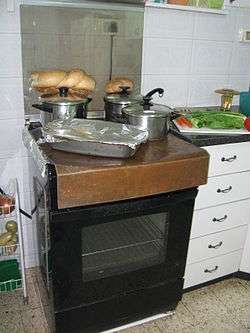Blech
A blech (from the Yiddish word בלעך (blekh) meaning "tin" or "sheet metal") is a metal sheet used by many observant Jews to cover stovetop burners (and for some, the cooker's knobs and dials) on Shabbat (the Jewish Sabbath), as part of the precautions taken to avoid violating the halachic prohibition against cooking on the Sabbath.

Common use
Rabbi Fishel Jacobs' The Blech Book—The Complete & Illustrated Guide To Shabbos Hotplates[1] gives the following guidelines:-
- The food (including water) intended for Shabbat use should be completely cooked.
- The stove’s gas flames or electric coils are turned on. The blech is placed over these. Alternatively, the Shabbat hot plate, which needs no blech (when it is the type which has no knobs to adjust the heat level) is plugged in.
- The pot is placed on the blech. It is permissible to place another pot on this one.
- The pot on the blech, or another pot which has been placed on it, may be covered with a blanket, clothing, towel, cloth, etc., to keep the heat from dissipating. One side of the pot should be left partially uncovered.
During Shabbat, the pots are removed according to need. After removal, it is permissible to return the pot onto the blech, following these guidelines:
- The pot should be removed from the blech with the intention to replace it afterwards and held at all times, not leaned onto any surface. (A heavy or unwieldy pot may be partially leaned on a surface, while being held, if there is no alternative.)
- The food must be in the same pot, completely cooked, and has retained at least some of its original heat.
The permissibility of blech (and unblech, below) and the acceptable manner of their use is questioned by several modern kashrut organizations;[2] however, the use of a blech to reheat food on the Sabbath remains very popular among observant Jews.[3]
Unblech
An unblech, or K'Deira Blech (lit. "pot blech", commonly referred to as "water blech"), is also used to heat up pre-cooked food on the Sabbath, but utilizes different halakhic mechanisms from a standard blech. An unblech consists of a shallow metal pan filled with hot water and covered by another metal pan, and thus is akin to a bain-marie or double boiler for halakhic purposes. As such, it may be more flexible than a standard blech for halachic purposes. However, the temperature of an unblech is limited by the boiling point of water and is not as hot as a typical blech.
Fire safety
In 2015, a house fire caused by a faulty Shabbat hot plate killed seven children in Brooklyn, New York City, New York. The 2015 fire was preceded by at least four other Shabbat fires in Brooklyn in the past 15 years caused by appliances for heating food being left on or candles burning during the Jewish Sabbath in order to comply with Orthodox interpretation of Jewish Law.[4] In 2005, three children died in a fire in Williamsburg, Brooklyn caused when stove burners were left on during Passover.[5] After the 2015 fire, the New York City Fire Department distributed a pamphlet titled "Fire Safety for Jewish Observances" to nearby homes.[6] In response to the fire, many Jews in Brooklyn purchased smoke detectors before the following Sabbath.[7][8]
References
- "The Blech Book," on Amazon.com Retrieved 22-March-2015
- See, for example, Warming Food on Shabbos by Rabbi David Cohen Archived September 28, 2007, at the Wayback Machine, stating in part, "Even if food is fully cooked, hot, and not wrapped, Chazal legislated that it may not be put into the fire or onto a blech." But see Ovadia Yosef, Yehave Daat, Vol 2, #45; and Pinchas Toledano, Fountain of Blessings, Vol. 2, p. 67.
- Shimoni, Giora. "What is a Blech?". about.com. Retrieved 2010-05-22.
- "A Deadly Plague of Shabbat Fires". Jewish Daily Forward. 22 March 2015. Archived from the original on 24 March 2015. Retrieved 20 March 2015.
- Briquelet, Kate (March 22, 2015). "Orthodox Jewish Custom Poses Deadly Fire Danger". New York Post. Retrieved 2015-03-22.
- Yee, Vivian; Schwirtz, Michael (March 22, 2015). "Deadly Fire in Brooklyn Renews Concerns Over a Weekly Ritual". New York Times. Retrieved 2015-03-22.
- Otterman, Sharon (26 March 2015). "Orthodox Jews in Brooklyn Rush to Buy Smoke Detectors Before Sabbath". New York Times. Retrieved 27 March 2015.
- Moftah, Lora (27 March 2015). "Sabbath Safety: Brooklyn Fire Spurs Orthodox Jewish Rush For Smoke Detectors, Fire Safety Info". International Business Times. Retrieved 27 March 2015.
See also
- Cholent
- Cooking on Shabbat